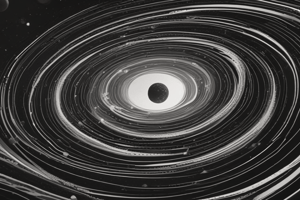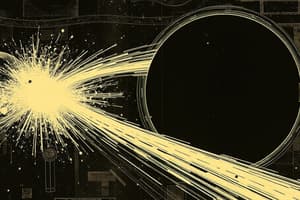Podcast
Questions and Answers
What is the defining feature of a black hole's singularity?
What is the defining feature of a black hole's singularity?
- Infinite density and zero volume (correct)
- High temperature and large volume
- Negligible mass and infinite volume
- Low density and high volume
Which type of black hole is typically found at the center of galaxies like the Milky Way?
Which type of black hole is typically found at the center of galaxies like the Milky Way?
- Supermassive black holes (correct)
- Stellar mass black holes
- Intermediate-mass black holes
- Mini black holes
What is the region beyond which nothing can escape a black hole called?
What is the region beyond which nothing can escape a black hole called?
- Space-time distortion zone
- Event horizon (correct)
- Gravitational lens
- Singularity point
What is the primary factor that determines the category of a black hole?
What is the primary factor that determines the category of a black hole?
What happens to light that enters the event horizon of a black hole?
What happens to light that enters the event horizon of a black hole?
Why are black holes considered to have a 'gravity-defying' property?
Why are black holes considered to have a 'gravity-defying' property?
What phenomenon is described by Einstein's Theory of General Relativity?
What phenomenon is described by Einstein's Theory of General Relativity?
How are black holes primarily detected?
How are black holes primarily detected?
What did the Event Horizon Telescope (EHT) imagery of black holes in 2022 reveal?
What did the Event Horizon Telescope (EHT) imagery of black holes in 2022 reveal?
What is Hawking radiation according to Stephen Hawking's proposal?
What is Hawking radiation according to Stephen Hawking's proposal?
What is the potential application of black holes in space propulsion called?
What is the potential application of black holes in space propulsion called?
What theoretical concept could form a shortcut through space and time for travel between distant locations?
What theoretical concept could form a shortcut through space and time for travel between distant locations?
Flashcards are hidden until you start studying
Study Notes
Space: Unraveling the Mysteries of Black Holes
Black holes represent one of the most fascinating and yet enigmatic entities in the realm of space. Their strangeness and gravity-defying properties have captivated scientists and the public alike for decades. In this exploration, we'll dive into the world of black holes, shedding light on their origins, their impact on our universe, and the ongoing quest to unravel their mysteries.
What are Black Holes?
Black holes are the remnants of massive stars that have gone through a supernova explosion, leaving behind an extremely dense object with a gravitational pull so strong that nothing, not even light, can escape their grasp. The singularity at their core, a region of infinite density and zero volume, is covered by an event horizon — the point of no return beyond which nothing can escape.
Formation and Properties
Black holes come in various sizes, categorized into three main types: stellar mass black holes (around 5 to 50 times the Sun's mass), intermediate-mass black holes (around 100 to 10,000 times the Sun's mass), and supermassive black holes (around millions to billions of times the Sun's mass). The latter is often found at the center of galaxies, such as our own Milky Way, which hosts a supermassive black hole known as Sagittarius A*.
Because black holes are so dense, their gravitational pull is immense, distorting space-time around them. This phenomenon is known as spacetime curvature, and it is described by Einstein's Theory of General Relativity. The bending of light by black holes has been observed and is one of the key ways these objects have been detected.
Event Horizon Telescope Observations
In April 2019, the Event Horizon Telescope (EHT) collaboration released the first direct image of a black hole, specifically the supermassive black hole M87* at the center of galaxy M87. The image, revealing a ring-like structure, confirmed key predictions about black holes and spacetime curvature.
Since then, the EHT has continued to observe black holes, revealing more details about their properties and nature. The latest imagery, released in 2022, showed that the black hole Sagittarius A* at the center of the Milky Way is surrounded by a bright, asymmetric ring of light and is the first clear evidence that black holes can have an asymmetric appearance.
Theories and Speculation
Black holes are still largely enigmatic, and there are many theories and hypotheses attempting to explain their behavior. One of the most fascinating is the concept of Hawking radiation, proposed by Stephen Hawking, which suggests that black holes emit low-energy particles (hawking quanta) through their event horizons. This phenomenon suggests that black holes are not completely black but emit a tiny amount of radiation, slowly shrinking over time.
Another exciting idea is the concept of wormholes, which, as proposed by Einstein and his colleague Nathan Rosen, could form a shortcut through space and time to allow travel between distant locations in our universe. However, the existence of wormholes has yet to be conclusively proved, and they remain an intriguing theoretical possibility.
Future Exploration
As research continues, scientists are working to unravel the mysteries of black holes and their potential applications. One such area of interest is the use of black holes as a tool for space propulsion, such as the Alcubierre drive, which relies on the warping of spacetime around a black hole to create a "warp bubble" that would allow for faster-than-light travel.
In conclusion, black holes continue to captivate our imagination and ignite the scientific curiosity of our time. Despite their uniqueness and the challenges they present, they provide a window into the universe's most profound mysteries. With continued research and exploration, we may one day fully understand these elusive phenomena and unlock their potential applications.
Studying That Suits You
Use AI to generate personalized quizzes and flashcards to suit your learning preferences.





